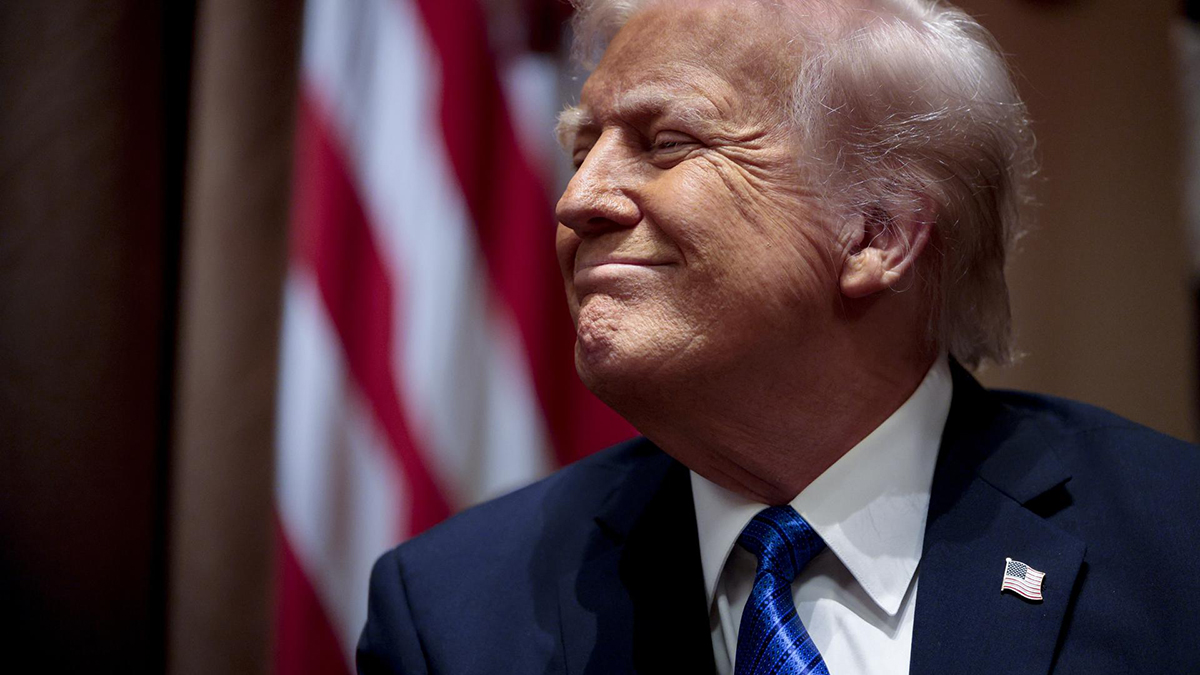Because it straddles the Arctic Circle among the United States, Russia and Europe, Greenland is a geopolitical prize that the U.S. and others have eyed for more than 150 years. It’s even more valuable as the Arctic opens up more to shipping and trade.
When U.S. President Donald Trump first suggested buying Greenland in 2019, some thought it was just a joke. But that is now far from the case.
Vice President JD Vance, his wife and other senior U.S. officials visited an American military base in Greenland on Friday, with the vice president saying the Trump administration is very interested in “Arctic security.”
The trip comes as relations between the U.S. and the Nordic country have soured after Trump repeatedly suggested the United States should, in some form, control the mineral-rich territory of Denmark — a traditional U.S. ally and NATO member.
Trump’s interest in Greenland, restated vigorously soon after he returned to the White House in January, comes as part of an aggressively “America First” foreign policy platform that includes demands for Ukraine to hand over mineral rights in exchange for continued military aid, threats to take control of the Panama Canal, and suggestions that Canada should become the 51st U.S. state.
So why does Trump want control of Greenland?
Here's what to know:
Why Greenland?
Politics
Increasing international tensions, global warming and the changing world economy have put Greenland at the heart of the debate over global trade and security, and Trump wants to make sure that the U.S. controls this mineral-rich country that guards the Arctic and North Atlantic approaches to North America.
In Washington, Trump said the U.S. “needs Greenland for international security.”
Feeling out of the loop? We'll catch you up on the Chicago news you need to know. Sign up for the weekly Chicago Catch-Up newsletter.
Trump, speaking to reporters soon after Vance’s arrival at the military base, alluded to the rising Chinese and Russian interest in the Arctic, where sea lanes have opened up because of climate change.
“Greenland’s very important for the peace of the world,” Trump said. “And I think Denmark understands, and I think the European Union understands it. And if they don’t, we’re going to have to explain it to them.”
Who does Greenland belong to?
Greenland is a self-governing territory of Denmark, a long-time U.S. ally that has rejected Trump’s overtures. Denmark has also recognized Greenland’s right to independence at a time of its choosing.
Amid concerns about foreign interference and demands that Greenlanders must control their own destiny, the island’s prime minister called an early parliamentary election.
Ahead of Vance's arrival, four of the five parties elected to Greenland's parliament signed an agreement to form a new, broad-based coalition government. The parties banded together in the face of Trump's designs on the territory.
“It is a time when we as a population are under pressure,” the prime minister-designate, Jens-Frederik Nielsen, said before the accord was signed to applause and cheers in the capital, Nuuk.
He added that “we must stick together. Together we are strongest,” Greenland broadcaster KNR reported.
In a post on Instagram, Danish Prime Minister Mette Frederiksen congratulated Nielsen and his incoming government, and said that “I look forward to close cooperation in an unnecessarily conflict-filled time.”
Frederiksen said on Tuesday that the U.S. visit, which was originally set for three days, created “unacceptable pressure." She has said that Denmark wants to work with the U.S. on defense and security, but Greenland belongs to the Greenlanders.
What to know about Greenland
The world’s largest island, 80% of which lies above the Arctic Circle, is home to about 56,000 mostly Inuit people who until now have been largely ignored by the rest of the world.
As the nautical gateway to the Arctic and North Atlantic approaches to North America, Greenland has broader strategic value as both China and Russia seek access to its waterways and natural resources.
Why are other countries interested in Greenland?
Climate change is thinning the Arctic ice, promising to create a northwest passage for international trade and reigniting the competition with Russia, China and other countries over access to the region’s mineral resources.
“Let us be clear: we are soon entering the Arctic Century, and its most defining feature will be Greenland’s meteoric rise, sustained prominence and ubiquitous influence,’’ said Dwayne Menezes, managing director of the Polar Research and Policy Initiative.
“Greenland — located on the crossroads between North America, Europe and Asia, and with enormous resource potential — will only become more strategically important, with all powers great and small seeking to pay court to it. One is quite keen to go a step further and buy it.”
Arctic competition
Following the Cold War, the Arctic was largely an area of international cooperation. But climate change, the hunt for scarce resources and increasing international tensions following Russia’s invasion of Ukraine are once again driving competition in the region.
Strategic importance
Greenland sits off the northeastern coast of Canada, with more than two-thirds of its territory lying within the Arctic Circle. That has made it crucial to the defense of North America since World War II, when the U.S. occupied Greenland to ensure that it didn’t fall into the hands of Nazi Germany and to protect crucial North Atlantic shipping lanes.
The U.S. has retained bases in Greenland since the war, and the Pituffik Space Base, formerly Thule Air Force Base, supports missile warning, missile defense and space surveillance operations for the U.S. and NATO. Greenland also guards part of what is known as the GIUK (Greenland, Iceland, United Kingdom) Gap, where NATO monitors Russian naval movements in the North Atlantic.
Natural resources
Greenland has large deposits of so-called rare earth minerals that are needed to make everything from computers and smartphones to the batteries, solar and wind technologies that will power the transition away from fossil fuels. The U.S. Geological Survey has also identified potential offshore deposits of oil and natural gas.
Greenlanders are keen to develop the resources, but they have enacted strict rules to protect the environment. There are also questions about the feasibility of extracting Greenland’s mineral wealth because of the region’s harsh climate.
Climate change
Greenland’s retreating ice cap is exposing the country’s mineral wealth and melting sea ice is opening up the once-mythical Northwest Passage through the Arctic.
Greenland sits strategically along two potential routes through the Arctic, which would reduce shipping times between the North Atlantic and Pacific and bypass the bottlenecks of the Suez and Panama canals. While the routes aren’t likely to be commercially viable for many years, they are attracting attention.
Chinese interest
In 2018, China declared itself a “near-Arctic state” in an effort to gain more influence in the region. China has also announced plans to build a “Polar Silk Road” as part of its global Belt and Road Initiative, which has created economic links with countries around the world.
Then-U.S. Secretary of State Mike Pompeo rejected China’s move, saying: “Do we want the Arctic Ocean to transform into a new South China Sea, fraught with militarization and competing territorial claims?” A Chinese-backed rare earth mining project in Greenland stalled after the local government banned uranium mining in 2021.
Independence
The legislation that extended self-government to Greenland in 2009 also recognized the country’s right to independence under international law. Opinion polls show a majority of Greenlanders favor independence, though they differ on exactly when that should occur. The potential for independence raises questions about outside interference in Greenland that could threaten U.S. interests in the country.



